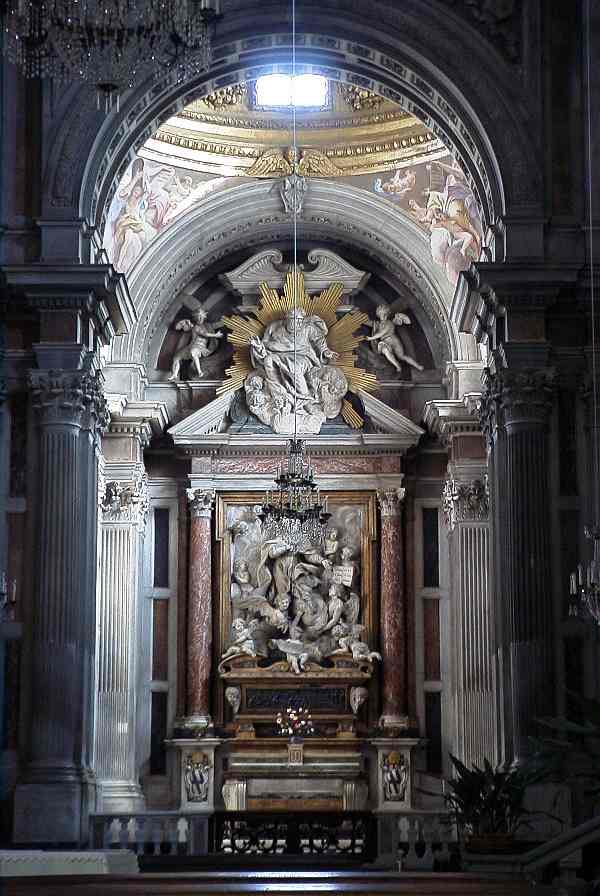

By now we were expert navigators of close-in Florence, having mastered our one bus line and knowing how to look up for the Cathedral Dome or the Palazzo Vecchio to get our directions anywhere north of the river. The South side proved fairly easy to navigate and after a great lunch in the typical unknown Tuscan restaurant, we were off to a visit to a landmark of the early Italian Renaissance, the Brancacci Chapel, found in the South transept of yet another church with an unfinished front, the Church of Santa Maria del Carmine.
Like most of Florence's aged jewels, this chapel has a long history of political and physical challenges. In fact, a fire in 1771 gutted the church, destroyed the early renaissance ceiling, and damaged the magnificent frescoes on the walls of the Brancacci Chapel.
The Renaissance started in Florence; and this city led that movement for a century in large part because of this chapel. The later masters (Leonardo, Michelangelo, Raphael, etc.) came to study its walls. Renaissance painting, in fact, is thought to have started with these frescoes.
The work was started by two early masters: Masaccio and Masolino were apparently good friends who shared the commission and took turns decorating the walls, alternating frescoes on the same wall, working from a common plan and extolling the virtues of Saint Peter (who symbolized the papacy, an institution fighting with the emperor for political dominance in Florence as well as the rest of Italy). They employed perspective, having the light come from a single source coincident with the natural lighting of the chapel and casting shadows appropriately. Their work is so integrated that for many centuries, art scholars argued about who painted which picture. (They apparently have that kind of time).
By far the more influential was Masaccio who started painting these frescoes around 1425--in his early twenties. He would die in Rome at age 26 leaving the chapel unfinished. Despite his short life-span, Masaccio (whose name means "clumsy Tom" because of his disorganized but well-meaning nature), left art permanently changed.
Most of my photos did not come out (due to the dreaded no tripod rule), but I was able to snare the one of Masaccio's famous Expulsion from Paradise at the top of this page. The colors (especially the blue sky) have been damaged by the great fire but fortunately a recent restoration removed the fig leaves added during more prudish times. (Maybe your web firewall has put them back in?). After being appropriately overwhelmed by the expressions, did you note the shadows and the three dimensionality of the figures that Masaccio picked up from his sculptor friend, Donatello and the architect Brunelleschi (the Florence dome guy), key Renaissance figures in their own right?
To see Adam and Eve in context on the left chapel wall, click here. This will show you a little of what the Encyclopedia Britannica calls a Renaissance icon rivaling Michelangelo's David -- Masaccio's The Tribute Money. In fact, some of Michelangelo's earliest drawings were sketches of the Masaccio fresco.
Unfortunately the rest of the church of St. Maria del Carmine was closed but we did sneak this picture of the North transept -- opposite the Brancacci chapel to give you some idea of the rest of the church:

After the chapel, we finished our last day in Florence at the Boboli Gardens and the Palazzo Pitti on the same side (south) of the Arno. Please join us by clicking here.
Want to see more of Mosaccio's paintings? If so, try this link.
Wanted to study this chapel in depth? If so, here's the mother of all Brancacci sites.
I am forced to tolerate ads by my good friends who give me home page space. However, here is a totally unsolicited ad from what is becoming my favorite online area, the Encyclopedia Britannica. I'm sure my siblings remember those massive black tomes that took up their own bookshelf in our living room while we all attempted to grow up. Not even Tom could read all of them. Now their wisdom is available free and online. Try out this article on the Renaissance to appreciate their depth:
Where do you want to go today? Here's a few choices:
